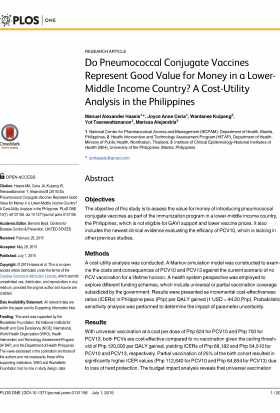This website uses cookies so that we can provide you with the best user experience possible. Cookie information is stored in your browser and performs functions such as recognising you when you return to our website and helping our team to understand which sections of the website you find most interesting and useful.
Do Pneumococcal Conjugate Vaccines Represent Good Value for Money in a Lower- Middle Income Country? A Cost-Utility Analysis in the Philippines (2015)

รายละเอียดเพิ่มเติม
Manuel Alexander Haasis1*, Joyce Anne Ceria1, Wantanee Kulpeng2,
Yot Teerawattananon2, Marissa Alejandria3
1 National Center for Pharmaceutical Access and Management (NCPAM), Department of Health, Manila,
Philippines, 2 Health Intervention and Technology Assessment Program (HITAP), Department of Health,
Ministry of Public Health, Nonthaburi, Thailand, 3 Institute of Clinical Epidemiology-National Institutes of
Health (NIH), University of the Philippines, Manila, Philippines
Abstract
Objectives
The objective of this study is to assess the value for money of introducing pneumococcal conjugate vaccines as part of the immunization program in a lower-middle income country, the Philippines, which is not eligible for GAVI support and lower vaccine prices. It also includes the newest clinical evidence evaluating the efficacy of PCV10, which is lacking in other previous studies.
Methods
A cost-utility analysis was conducted. A Markov simulation model was constructed to examine the costs and consequences of PCV10 and PCV13 against the current scenario of no PCV vaccination for a lifetime horizon. A health system perspective was employed to explore different funding schemes, which include universal or partial vaccination coverage subsidized by the government. Results were presented as incremental cost-effectiveness ratios (ICERs) in Philippine peso (Php) per QALY gained (1 USD = 44.20 Php). Probabilistic sensitivity analysis was performed to determine the impact of parameter uncertainty.
Results
With universal vaccination at a cost per dose of Php 624 for PCV10 and Php 700 for PCV13, both PCVs are cost-effective compared to no vaccination given the ceiling threshold of Php 120,000 per QALY gained, yielding ICERs of Php 68,182 and Php 54,510 for PCV10 and PCV13, respectively. Partial vaccination of 25% of the birth cohort resulted in significantly higher ICER values (Php 112,640 for PCV10 and Php 84,654 for PCV13) due to loss of herd protection. The budget impact analysis reveals that universal vaccination would cost Php 3.87 billion to 4.34 billion per annual, or 1.6 to 1.8 times the budget of the current national vaccination program.
Conclusion
The inclusion of PCV in the national immunization program is recommended. PCV13 achieved better value for money compared to PCV10. However, the affordability and sustainability of PCV implementation over the long-term should be considered by decision makers.
Full text can be accessed from:
http://journals.plos.org/plosone/article?id=10.1371/journal.pone.0131156




